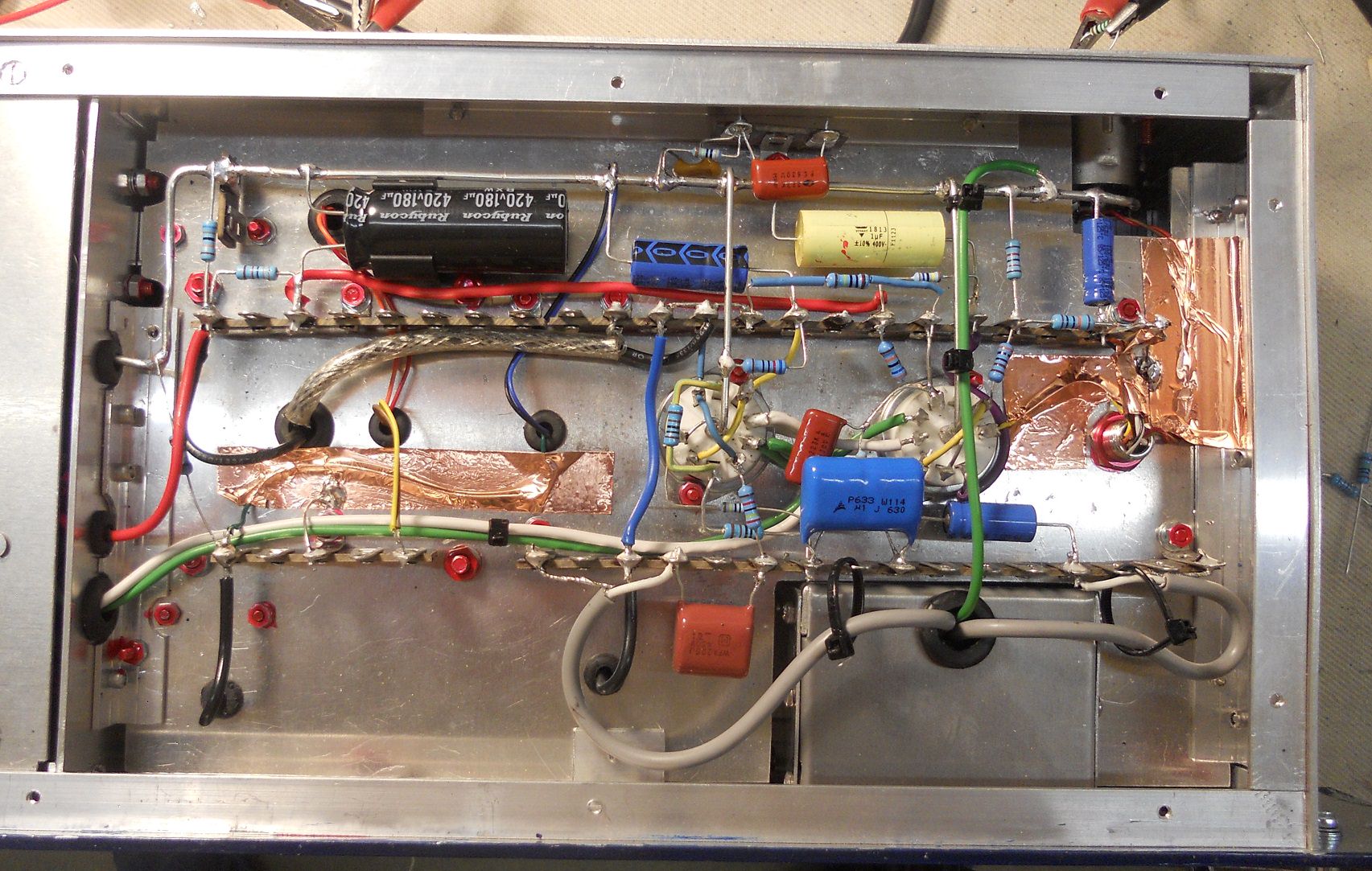Ian has now tested the mic-pre and these are his results:-
Day 1
The mic pre turned up this morning. I have just finished giving it a quick run through. The performance looks very good so far. I have not made any accurate measurements but I can tell you that:
1. EIN looks to be well below -120dBu
2. Distortion is well below 1% at over +20dBu into a 600 ohms load at 1KHz.
3. Frequency response looks flat out past 40KHz (which is as far as I can measure right now)
4. There is a peak of just under 8dB at just below 7Hz at maximum gain. This is either the resonance of the output capacitor with the primary inductance of the output transformer or the an effect of negative feedback. I have not tried it at other gains.
Day 2
Tonight I managed to carry out a few more accurate tests using my Lindos test set. It produces very accurate signal levels so first I used it to test the actual gain at each gain setting by setting the Lindos output to minus the gain in dBu so the output should always be 0dBu. The Lindos has an input impedance of 20K so these are unloaded gains. The gain error at each gain setting was as follows:
55dB +0.31dB
50dB +0.01dB
45dB -0.23dB
40dB -0.45dB
35dB -0.26dB
30dB -0.25dB
25dB -0.14dB
20dB -0.74dB
I then measured the noise at each gain setting. These a quasi peak readings using the C weighting network. The input was shorted. The results were:
Gain Noise
20dB -87dBu
30dB -85dBu
40dB -81dBu
45dB -77dBu
50dB -72dBu
55dB -67dBu
This represents an EIN of -122dBu which, with this weighting network, is a very good result.
Lastly I measured the 1KHz distortion into a 600 ohm load at various levels. These were all done at 20dB gain. The results were:
Level Distortion
0dBu 0.075%
+5dBu 0.049%
+10dBu 0.048%
+15dBu 0.40%
+20dBu 0.64%
+25dBu 1.04%
Again these are very respectable results.
Right now it is not clear if the cause of the LF peak is an output transformer and coupling capacitor resonance or a NFB artefact. Because your design alters open loop gain with closed loop gain, the amount of NFB does not vary much so the size of the peak would probably be independent of gain setting. In a more conventional design where open loop gain is fixed, you would be able to see the peak alter with gain setting if it was due to NFB.
The output cap and the transformer primary form a series resonant circuit which is damped by the transformer primary dcr so to increase damping you would need to add series R not a parallel one. But this would increase the output impedance and reduce the drive capability of the amp which you probably do not want to do.
Day 3.
I have repaired my test interface box and conducted some detailed frequency response and noise tests using REW. First, here is a screen showing the low frequency response at 20dB gain:
As you can see, the peak appears to be at about 11Hz and is about 9dB high. Yesterday when I measured it I got a frequency of about half this and and amplitude of 7dB but I am fairly sure this was due to the faulty switch in my test interface box. I repeated the test at 40dB gain with the same result which unfortunately does not tell us a lot. What I will do is repeat the test with the output loaded with 10K rather than 600 ohms to determine if the effect is load related.
I then switched the sampling rate to 96KHz and looked at the high frequency response:
As you can see, it is flat out to beyond 40KHz. The sudden drop you can see is the solely due to the sample rate being reached; it is not the response of the amplifer.
Lastly I measured the noise noise spectrum at 55dB gain into a 600 ohm load with the input shorted (I did later check with a 150 ohm input source but the value was unchanged as is typical for tube mic pres):
The first thing to note is that 0dBFs is +10dBu so you need to add 10dB to the figures in the graph. This means the 50Hz mains frequency and its harmonics at 150Hz and 250Hz are below -90dBu at this gain which is an excellent result. If you look at the top right bubble you will see the rms noise is -80dBFS which is -70dBu. Since we know the gain is 55dB, this gives an EIN of -125dBu which is very good. If you want to play salesman you could always quote the A weighted figure, which is also shown, at -86.7dBFS which is -76.7dBu which gives an A weighted EIN of -131.7dBu.
I have now checked the frequency response into a 22K load and the low frequency response is unchanged so it cannot be anything load related. However, I did notice that there is now an HF peak that was not there when loaded with 600 ohms. The peak occurs around 25KHz (see attached graph). You may need to consider fitting a Zobel network.
The V241-76 has now been shipped to a studio for sound evaluation. In the meantime I will make some tests to sort out the 11Hz peak, but as there are unlikely to be many recorded sounds that low, (or as high as 25kHz) I decided to let the sound test begin as it is. The square wave performance is very good, but unfortunately, this often goes hand in hand with peaks in the ultrasonic. The Jensen IPT is not terminated.
What pleases me most is the very low noise figure. All that MuMetal and copper screening has played a significant part in that.
It also just goes to show that an ordinary Edicron EF86 pentode can do the business, given the right circuit.
DaveP












































